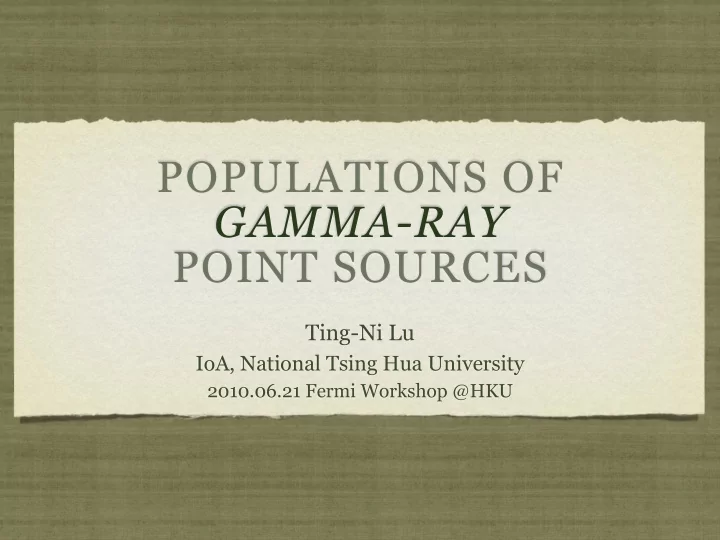

POPULATIONS OF GAMMA-RAY POINT SOURCES Ting-Ni Lu IoA, National Tsing Hua University 2010.06.21 Fermi Workshop @HKU
OUTLINE Gamma-ray in Astronomy Emission Mechanisms Instruments Development Populations of Gamma-ray sources Catalogues
GAMMA-RAY?
GAMMA-RAY?
GAMMA-RAY? Highest energy photons, a few hundred keV to TeV. Probe nuclear and elementary particles. Probe the most violent/relativistic activities, or extreme environments in Astronomy.
GAMMA-RAY IN ASTRONOMY? Producing gamma-rays ➙ Blackbody with temperature higher than 2 × 10 9 K ➙ Compton scattering ➙ Nuclear transition ➙ Decays, Annihilation ➙ Changed particles + Electric fields/Magnetic fields Synchrotron radiation, Bremsstrahlung radiation Gamma-rays interact with environments
DETECT GAMMA-RAY High energy photons are blocked by our Earth’s atmosphere.
DETECT GAMMA-RAY Small effective area (aperture) compared to that in other wavelengths. Ground-based (higher energy regime: 10 GeV to TeV) ➙ Cherenkov cascade ➙ Optical detectors Balloon/Space-borne (lower energy regime: MeV to GeV/TeV) ➙ Pair production ➙ Inverse Compton scattering ➙ Gamma-ray detectors
GAMMA-RAY TELESCOPE.SATELLITE Started Since 1960s. ➙ Gamma-ray bursts were first detected by the U.S. military satellites (Vela satellites) in the late 1960s. ➙ SAS-II & COS-B provided the first accurate maps of the Milky Way, and discovered Geminga. ➙ HEAO-C first discovered radioactive 26 Al line (1.809 MeV). Matured from 1990s ➙ SIGMA provided the first high resolution images of X-ray novae and microquasars. ➙ Compton Observatory provided the first all-sky survey. ➙ WHIPPLE Telescope detect the first secured TeV source, Crab.
TIMELINE Pinkau 2009
HIGH ENERGY STEREOSCOPIC SYSTEM Cherenkov telescope, 100 GeV to 100 TeV. Total mirror area is 108 m 2 per telescope; 5 o field of view; Diameter 12 m; Focal length 15 m (f/d ~1.2); PSF 0.03 o (rms) on axis, 0.06 o for rays 2 o off axis; Energy Resolution ~15%; Time Required for a 5 σ Detection at 20 o ~ 0.01 Crab in ~25 hrs (1Crab=1.75 × 10 -11 (erg/TeV) -1.62 cm -2 s -1 ) Phase I: 4 telescopes separated by 120 m. Phase II: an single huge dish with about 600 m 2 mirror area will be added at the center of the array, increasing the energy coverage, sensitivity and angular resolution of the instrument.
NUCLEAR COMPTON TELESCOPE NCT is a balloon-borne soft gamma-ray (0.2-15 MeV) telescope designed to study astrophysical sources of nuclear line emission and gamma-ray polarization, also a collaboration between UC Berkeley and Taiwan. NCT will perform Compton imaging in the 0.2-10 MeV gamma-ray band, with an overall FOV of 25% of the sky and 0.45% energy resolution. Major scientific topics of the NCT project include the galactic 511-keV line emission, origin of Al-26, and polarization of gamma-ray emission from pulsars, etc.
FERMI GAMMA-RAY SPACE TELESCOPE Pair production
FERMI GAMMA-RAY SPACE TELESCOPE
GAMMA-RAY SKY
GAMMA-RAY SKY
GAMMA-RAY SKY
GAMMA-RAY SKY
POPULATIONS OF GAMMA-RAY SOURCES Pulsars X-ray binaries (HMXB, microquasar) Galaxies (Active Galactic Nuclei, Blazar) Supernovae explosion/remnant Gamma-ray burst Other issues Unidentified sources
Back PULSAR A neutron star which emits beams of radiation that sweep through the line of sight, and show pulses in their light curves. High speed electrons interact with magnetic fields. Spin-powered pulsar & accretion-powered pulsar. ➙ radio pulsar, X-ray pulsar, gamma-ray pulsar ➙ milli-second pulsar Gamma-ray observations could help distinguish different pulsar models.
X-RAY BINARIES Composed of a compact object and a normal star companion. High Mass X-ray Binaries (HMXBs) with a high mass companion Microquasar ➙ Black hole/neutron star HMXB ➙ gamma-rays from jets or pulsar winds ➙ eg., Cyg-X3 Back
GALAXIES Active Galactic Nuclei (AGN) ➙ scaled-up microquasar ➙ super-massive black holes accreting materials ➙ Blazars: jet-on AGNs ➙ Quasars: very distant AGNs Inverse Compton generated Gamma-rays from jets Back
SUPERNOVAE Explosion of massive stars and their remnants. Shocks, particle acceleration and interactions with environment, synchrotron radiation. Supernovae remnants are often associated with pulsar wind nebulae, eg., Crab and Vela. Possible sources of Cosmic rays and Gamma-ray burst. Back
GAMMA-RAY BURST Extra-galactic source; two distinct type ➙ long GRB and short GRB. A relativistic fireball model. Core collapse of massive stars (SNe). Mergers of two compact objects. Stellar collisions in globular clusters?
OTHER ISSUES Dark matter annihilation search Weakly interacting massive particles annihilate to produce gamma-rays Clusters of Galaxies? Ackermann et al. 2010, arXiv:1006.0748vi Back
DISCOVERIES FROM CATALOGUES Aharonian et al. 2005, Science New gamma-ray population? At least two of eight newly-discovered HESS sources have no identified counterpart in radio or x-rays, which suggests the exciting possibility of a new class of “dark” nucleonic particle accelerators. The HESS catalog provides insights into particle acceleration in our Galaxy and adds a piece to the long-standing puzzle of cosmic-ray origin.
DISCOVERIES FROM CATALOGUES Abdo et al. 2010, arXiv:1003.3588v1 Gamma-Rays from Globular Clusters
DISCOVERIES FROM CATALOGUES Abdo et al. 2010, arXiv:1003.3588v1 Gamma-Rays from Globular Clusters
DISCOVERIES FROM CATALOGUES Abdo et al. 2010, arXiv:1003.3588v1 Gamma-Rays from Globular Clusters
DISCOVERIES FROM CATALOGUES Abdo et al. 2010, arXiv:1003.3588v1 Gamma-Rays from Globular Clusters
DISCOVERIES FROM CATALOGUES Abdo et al. 2010, arXiv:1003.3588v1 Gamma-Rays from Globular Clusters
DISCOVERIES FROM CATALOGUES Abdo et al. 2010, arXiv:1003.3588v1 Gamma-Rays from Globular Clusters
DISCOVERIES FROM CATALOGUES Abdo et al. 2010, arXiv:1003.3588v1 Gamma-Rays from Globular Clusters
DISCOVERIES FROM CATALOGUES Abdo et al. 2010, arXiv:1003.3588v1 Gamma-Rays from Globular Clusters
DISCOVERIES FROM CATALOGUES Abdo et al. 2010, arXiv:1003.3588v1 Sources in globular clusters; New milli-second pulsars!?
KEEP WORKING, FIND SOMETHING. Thank you!
Recommend
More recommend